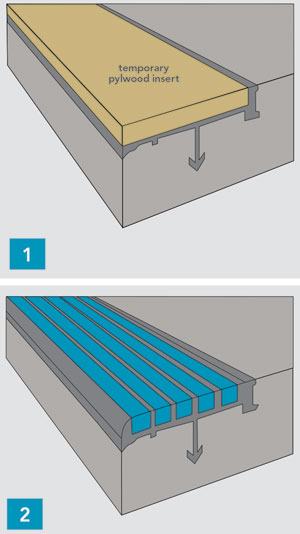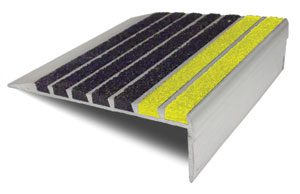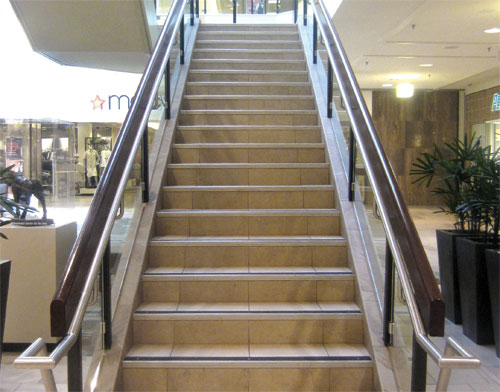Stair Treads and Nosings
Properly specifying treads and risers is directly linked to the type of stairs that they are being installed on. There are four basic choices available:
Poured concrete stair installation. Nosings are typically set along the edge of the concrete treads immediately after the concrete is poured and is intended to be flush with the surfaces of the treads and risers.
Steel pan installation. Nosings or treads are set into the concrete supported by the steel pan. Typically, this means a slightly different edge condition to assure that there is no lip protruding past the metal riser that might cause a tripping hazard.
Wood stair installation. Commonly this is a full tread application that sets into or over the wood.
Retrofit installation. This is also a full tread installation that is designed to cover over de-teriorated concrete or wood stairs and restore them to a safe condition.
Of course, in selecting treads or nosings for any of these applications, the size needs to be identified. Three- and four-inch nosing widths are standard since 3-inch or larger nosings will satisfy the requirements of virtually all codes and standards. Nonetheless, sizes ranging from 2 to 12 inches are commonly available for nosings and treads and need to be selected according to the size of the stairs and their construction accordingly.
 |
Two-stage nosing used in metal pan concrete filled stairs Images courtesy of Nystrom, Inc. |
Cast products typically don't offer many other choices beyond size, but extruded products offer numerous other options including the following:
Single-part products. These are the most commonly used tread and nosing products. They are installed as one piece into poured concrete stairs, onto steel pan concrete filled stairs, or onto wood stairs. In addition to choosing the width, the specific product nosing profile can be selected. For example, the front edge of the nosing will typically be aluminum that can be a short or long piece as appropriate to the installation. If long, then it can be made to suit a 90-degree riser or one that is sloped back. These products are also available as flat pieces without any nosing for use in ramps to provide the needed slip resistance for handicapped accessible and other sloped walking surface situations.
Two-part products. These are popular in steel pan concrete stair applications where concern about protecting the tread and nosing during construction is important. These work particularly well when the stairs need to be done early on a project and there are months of construction foot and equipment traffic going up and down the stairs. As the name implies, there are two pieces installed separately. First, a base plate unit is installed in the concrete fill as with the single part products. However they are shipped with a piece of plywood installed in place of the nominal 3-inch nosing. Later, after construction is nearly complete, the plywood is removed and the finished nosing is installed. Either ribbed or full abrasive nosings are available for this type of product.
Vision line. A contrasting color can be applied to the leading edge of ribbed treads in any color combination. This is particularly important in meeting vision-impaired handicapped accessibility requirements.
Range of colors. The abrasive aluminum oxide in treads and nosings can be specified in as many as nine common colors including black, safety yellow, brown, gray, red, burgundy, orange, green, and blue. Luminescent strips that glow in the dark when first exposed to light are also available in response to some recent code revisions calling for luminescent markings in stairways, particularly in the northeasternUnited States.
 |
A vision line tread with contrasting color for meeting vision-impaired handicapped accessibility requirements and general safety needs Photo courtesy of Nystrom, Inc. |
Taped tops. For protection during the initial pour, single-stage products can be shipped in some cases with protective tape covering the top or exposed part of the product. Tape must be removed immediately after the stair tread is set, however, so it only offers very short-term protection.
Painted undersides. To prevent a possible reaction between the concrete and the aluminum, the undersides of the treads and nosings can be specified to be coated with a protective paint to separate them from the concrete.
End miter cuts. In design situations where traffic direction changes or stairs turn a corner, it is possible to have the manufacturer or fabricator provide miter cut corners and edges for treads and nosings. The nature of extrusion manufacturing, however, does not lend itself to a curved stair tread with a radius shape.
Hardware. A range of anchor options are typically available including wood screws for wood stair applications, wing anchors with machine screws for concrete or steel pan applications, and nylon expansion shields with screws for renovation treads installed into existing concrete.
Adhesive. In some cases, construction adhesive may be the most appropriate means to secure renovation treads and is available as an option if anchoring is not possible or practical.
Building Information Modeling (BIM) for Treads and Nosings
With all of the choices and options available in design and construction and with the need to coordinate building components more closely, many architects, contractors, and building owners are increasingly turning toward building information modeling (BIM) as an effective and preferred tool in the process. BIM helps the entire project team investigate the options and visualize alternative conditions quickly and easily. It also reveals in three dimensions places that are in conflict so they can be resolved during design rather than the more costly resolution during construction.
Because there are many manufactured products that are documented and available in BIM format, it is more straightforward than ever to use this available library to make a final selection and actually customize products to suit a project's needs. In particular, it is increasingly common that manufacturers will offer tread and nosing computer files in a BIM format so they can be coordinated with the rest of the stair construction. Using the manufacturer's BIM files in the overall computer model will allow for full visualization of the appearance and functionality on different stair surfaces and allow the designers to make the best informed decisions on product selection.
 |
The use of a BIM model will help everyone on the design and construction team visualize a finished stair and safety tread installation while avoiding potential conflicts of materials in the field. Photo courtesy of Nystrom, Inc. |
When architects and engineers are considering BIM objects prepared by building product manufacturers to incorporate into an overall model, they should look for the following characteristics in those objects:
Up-to-date information readily available. Access to information when it is needed is critical to keeping a project on schedule. But that information has to be current and up to date, otherwise a lot of time is wasted detailing the wrong things. Historically, the architect has relied on manufacturer's representatives to update the office library with catalogs, CDs and other information for handy reference. The shortfall in this process is the possibility that the catalogs become out of date without a designer realizing it. Recognizing this, many product manufacturers offer their entire product and design information electronically on their company website. Others are working through independent company sources that provide manufacturer information in catalog and electronic format and are becoming sources of a growing library of BIM objects. Obviously, working with a manufacturer that can provide up-to-date, readily available BIM objects for inclusion in an overall BIM model will be easier than creating a generic object in the design studio.









